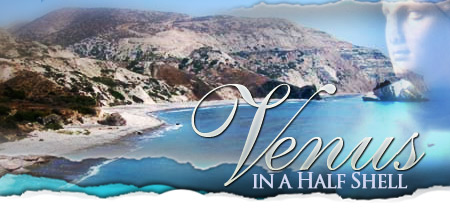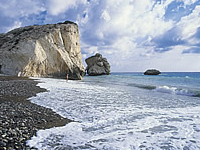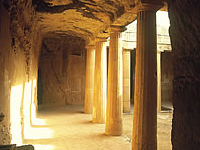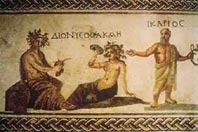
Find Romance in Paphos, Cyprus - The Birthplace of Love
By Amanda Castleman
Golden
rocks jut from the bay, where turquoise and jade waters mix in a spray of foam.
Surf polishes the bright cobblestones. The beach is pristine, a sublime curve
of coast. Small wonder the ancient Greeks believed Aphrodite sprang from the sea
here.
The
goddess of love emerged naked from the waves, according to legend. Her dramatic
birth has inspired artists and poets for millennia, including Botticelli's masterpiece,
irreverently nicknamed "Venus on a half shell". She
continues to entice visitors to the south-western coast of Cyprus, the third largest
island in the Mediterranean . Offerings shroud the bushes: strips of gaudy fabric,
small stuffed animals, toilet paper, bus tickets and expired phone cards. It's
the thought that counts, a native explained: "Leave something of yourself
for the goddess, no matter how small."
 |
|
You
can channel the spirit of Aphrodite here at the spot where the goddess of love
and beauty emerged from the sea. (Cyprus Tourism Organization) |
Aphrodite,
being a big-hearted girl, shares the lime-light. Her birthplace is formally known
as Petra tou Romiou, the Rocks of the Greek, to honour strong-man Digenis Akritas.
Folklore claims the frontier guard threw boulders at a Saracen ship.
Romantics
soon put their own spin on the three beige sea stacks: Bold swimmers who successfully circle
the cluster three times will dream of their future spouse.
Landlubbers
may prefer to pay homage at the deity's ancient shrine, four miles away at Old
Paphos (now called Kouklia). The sanctuary thrived for over 1500 years, flames
flickering on an "altar fragrant with incense," according to the poet
Homer.
Surprisingly,
mighty Aphrodite doesn't sport her usual dangerous curves here (perhaps she dresses
down at home, like so many mortal women). Ancients worshipped an abstract
image of a smooth black rock because art coudn't capture perfect
beauty.
Roman emperor Theodosius shut down the party when he banned pagan religions in
391 AD. The ruins, forgotten for five centuries, werel uncovered by the British
Cyprus Exploration Fund in 1888.
Fertility
cults have a way of blossoming again, though. Lawrence Durrell hinted at pagan
practices in his classic travelogue, Bitter Lemons of Cyprus (1957, Faber and
Faber). "The youths of Paphos still anoint the stones of the temple with
oil and almond-water on a certain night of the year, while women leave their rings
and fragments of their petticoats as ex votos against barrenness."
Today,
no offerings brighten the shattered ruins. The site and its two-room museum are
mainly for hard-core archaeology buffs.
Paphos,
on the other hand, is a guaranteed crowd-pleaser. Cheap and cheerful bars line
the palm-fringed bay. The Aquarium will charm visitors too immature - or mature
- for disco clubs. And the rest of us can bounce happily
between the beautiful beaches, riveting ruins and over-burdened tables in traditional
tavernas.
 |
The
Tomb of Kings, Paphos
(Cyprus Tourism Organization) |
The
resort town boasts not one, but two, World Heritage sites, which verges on gluttony. The
Tomb of Kings — a sprawling graveyard complex located a mile north of downtown
— is more famous, but somehow less satisfying. The fault lies partly with the
bewildering orientation pamphlet. Ignore the pamphlet and explore the ledge over the
turquoise sea for yourself.
Clover
and flowers bloom among the ornate tombs, hewn from rock between the 3rd century
BC and the 3rd century AD. The nickname is misleading: no royalty rested there,
just officials and rich citizens. The elaborate carvings, Doric pillars and wall-paintings
seemed fit for kings, though. Persecuted Christians and squatters later sheltered
in the underground chambers.
The
Paphos Mosaics, nestled in the crook of the harbour, are easier to
enjoy. Brave the souvenir gauntlet to reach the 2nd century AD masterpieces scattered
in a meadow. Allow at least two hours to explore the site.
The
more spectacular art is under cover: the House of Dionysus, House of Aion and
House of Orpheus, tucked under a tent. A handsome guidebook eliminates the guesswork,
explaining the mythology behind the mosaics. Just in case you're short a few bucks, RTM
provides a cheeky recap of
the romantic highlights.
 |
The
Paphos Mosaics
(Cyprus Tourism Organization) |
By
all means, linger over the intricate designs. Stroll along the coast to the lighthouse,
ancient market (Agora) and healing centre (the Asklepion). Even catch a boat tour
during high season. Then abandon the concrete shopping centres and head up the hill
to Ano Paphos, the upper city.
It's
possible to wander curving evocative alleys here, to lose yourself among the park's
frothing flowers and then stumble upon a tiny white church framed against an azure
sky. Break bread with the locals, far from the fish n' chips and golden arches.
Venture beyond the pre-fab "Tourist Area" and discover the genteel side
of Paphos, where you are a person first, a fat foreign wallet second.
Avoid
the temptation of staggeringly-cheap package deals, which herd visitors into the
seaside strip and abandon them to sunny, drunken revelry. Panama City, Florida,
offers the same charms much closer to home ... with proper margaritas to boot.
Only
an independent traveller can truly appreciate the isle of Aphrodite. Planning
is a breeze: Most Cypriots speak flawless English and are famous for their friendliness.
The modern road system is easy to navigate, though traffic flows on the left.
And the unexpected adventures, the hidden gems, will warm your heart for years
to come. Believe me, the flexibility is worth every penny.
As the saying goes, money
can't buy you love, but it can buy the freedom to explore Love's Island.
Sidebar: Romantic Tales Behind the Paphos Mosaics
If You Go...
Cyprus Tourism Organization
13 East 40th Street
New York, NY 10016
Phone: +121.268.352.80
gocyprus@aol.com
|